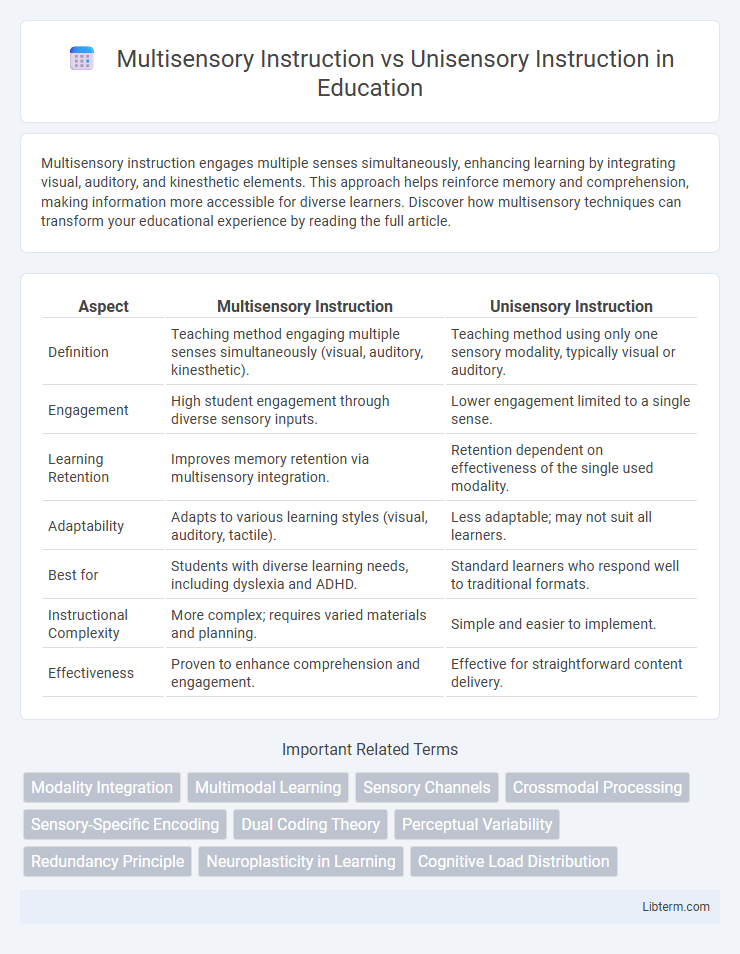Multisensory instruction engages multiple senses simultaneously, enhancing learning by integrating visual, auditory, and kinesthetic elements. This approach helps reinforce memory and comprehension, making information more accessible for diverse learners. Discover how multisensory techniques can transform your educational experience by reading the full article.
Table of Comparison
| Aspect | Multisensory Instruction | Unisensory Instruction |
|---|---|---|
| Definition | Teaching method engaging multiple senses simultaneously (visual, auditory, kinesthetic). | Teaching method using only one sensory modality, typically visual or auditory. |
| Engagement | High student engagement through diverse sensory inputs. | Lower engagement limited to a single sense. |
| Learning Retention | Improves memory retention via multisensory integration. | Retention dependent on effectiveness of the single used modality. |
| Adaptability | Adapts to various learning styles (visual, auditory, tactile). | Less adaptable; may not suit all learners. |
| Best for | Students with diverse learning needs, including dyslexia and ADHD. | Standard learners who respond well to traditional formats. |
| Instructional Complexity | More complex; requires varied materials and planning. | Simple and easier to implement. |
| Effectiveness | Proven to enhance comprehension and engagement. | Effective for straightforward content delivery. |
Introduction to Multisensory and Unisensory Instruction
Multisensory instruction engages multiple senses--visual, auditory, kinesthetic, and tactile--simultaneously to enhance learning and memory retention. Unisensory instruction, in contrast, relies on a single sensory modality, typically visual or auditory, which may limit instructional effectiveness for diverse learners. Research indicates multisensory approaches improve comprehension and skill acquisition, particularly in reading and language education.
Defining Multisensory Instruction
Multisensory instruction integrates visual, auditory, kinesthetic, and tactile elements to enhance learning by engaging multiple sensory pathways simultaneously. This approach contrasts with unisensory instruction, which relies on a single sensory modality, such as only auditory or only visual input. Research demonstrates that multisensory methods improve memory retention, comprehension, and skill acquisition by activating various brain regions and reinforcing neural connections.
Defining Unisensory Instruction
Unisensory instruction involves teaching methods that engage only one sensory modality, such as auditory or visual input, to deliver educational content. This approach contrasts with multisensory instruction, which simultaneously stimulates multiple senses to enhance learning and retention. Research shows that unisensory instruction can be effective for certain tasks but often limits information processing and learner engagement compared to multisensory techniques.
Cognitive Theories Behind Instructional Approaches
Multisensory instruction leverages cognitive theories such as dual coding theory and cognitive load theory by engaging multiple sensory modalities simultaneously, enhancing information encoding and retrieval through visual, auditory, and kinesthetic inputs. Unisensory instruction primarily relies on a single sensory channel, often limiting cognitive processing efficiency and depth of learning due to restricted sensory engagement. Research in cognitive psychology supports multisensory approaches as they reduce cognitive overload and improve working memory retention by distributing cognitive demands across different sensory pathways.
Research Evidence: Multisensory vs Unisensory Effectiveness
Extensive research evidences that multisensory instruction enhances cognitive retention and skill acquisition compared to unisensory methods by engaging visual, auditory, and kinesthetic pathways simultaneously. Studies indicate that learners exposed to multisensory techniques show improved memory recall, increased attention, and higher transfer of knowledge across diverse tasks. Neuroimaging findings corroborate these behavioral outcomes by demonstrating greater neural activation and connectivity in multisensory learning environments.
Benefits of Multisensory Instruction
Multisensory instruction engages multiple senses simultaneously, enhancing memory retention and comprehension by creating stronger neural connections. This approach caters to diverse learning styles, improving academic performance and increasing student motivation. Research shows multisensory techniques significantly boost reading skills, particularly in learners with dyslexia and other learning disabilities.
Limitations of Unisensory Instruction
Unisensory instruction limits learning effectiveness by engaging only one sensory modality, such as auditory or visual, which constrains information retention and comprehension. This approach often results in reduced student engagement and fails to accommodate diverse learning styles or cognitive preferences. Research shows that multisensory instruction enhances neural connections and improves memory recall by simultaneously stimulating multiple sensory pathways.
Practical Classroom Strategies for Multisensory Teaching
Multisensory instruction integrates visual, auditory, kinesthetic, and tactile activities to enhance student engagement and retention, contrasting with unisensory methods that rely on a single sensory input. Practical classroom strategies for multisensory teaching include using manipulatives, incorporating movement-based activities, and combining visual aids with verbal explanations to support diverse learning styles. This approach has been shown to improve comprehension and memory in students with varied learning needs, especially those with dyslexia or ADHD.
Student Outcomes and Engagement Comparison
Multisensory instruction, engaging multiple senses such as visual, auditory, and kinesthetic, significantly enhances student outcomes by improving memory retention and comprehension compared to unisensory instruction, which relies on a single sensory input. Research indicates that students exposed to multisensory learning environments demonstrate higher levels of engagement and motivation, leading to improved academic performance and reduced learning difficulties. The integration of diverse sensory modalities caters to different learning styles, fostering deeper cognitive processing and increased classroom participation.
Choosing the Right Approach: Key Considerations
Selecting between multisensory instruction and unisensory instruction requires analyzing learners' individual needs, cognitive preferences, and the specific learning objectives. Multisensory approaches integrate visual, auditory, kinesthetic, and tactile stimuli to enhance memory retention and engagement, making them ideal for diverse or struggling learners. Unisensory instruction, typically focusing on a single sensory channel, may be more effective for targeted skill development or learners with specific sensory processing preferences.
Multisensory Instruction Infographic

 libterm.com
libterm.com